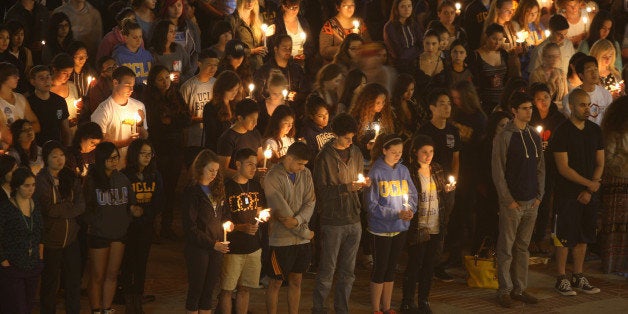
Elliot Rodger is a college president's worst nightmare: the unstable student whose deep illness only becomes clear in the aftermath of a homicidal rampage. Even as our hearts go out to his victims, their families and the community of the University of California at Santa Barbara, we must take stock, once again, of our emergency plans, "active shooter" training and threat assessment protocols. And as was true last time and the time before and before that, we are left with a sick feeling that, somehow, no amount of planning or drilling or the presence of well-trained counselors and staff will ever be enough. The psychopath has the capacity to blow past our defenses.
Sexual assault on college campuses has been Topic A in Congress, at the White House and the U.S. Departments of Education and Justice in the past few months. But even as federal officials impose new mandates, surveys and training on college officials responsible for keeping students safe from sexual harm, a self-professed virgin with deep emotional problems unleashed unspeakable horror in the UCSB community. The murderous spree reminds us that sexual assault is not the only danger on college campuses these days, and for the many colleges and universities that actually do police student behavior carefully, sexual assault is not the biggest issue of concern, but student safety really is.
The inability to control anger, increasingly pervasive misogyny, alcohol and substance abuse, serious emotional instability and real mental illness are all significant issues that we see with increasing frequency among students of all ages, markers of larger social and cultural conditions that simplistic federal mandates cannot erase from campus realities. Consider the rampant misogyny that apparently drove Rodger and that also is a driver of so much sex abuse. Stories are emerging about the "Pick-up Artist Community" and a rival group that professes to hate them for exploiting men who can't seem to find women compliant enough to be victims.
Was Rodger's hatred of women fueled by internet chatter or association with a hate group? We may never know in his case, but we certainly know this much: despite increasingly burdensome federal mandates to survey, to test, to train, to adjudicate, to punish, to report, to control student behaviors, when a predator is on the hunt, colleges and universities are no more able to control dysfunctional human behavior than other societal institutions. We also know that violence against women and appalling misogyny are rampant social problems, with even women injured by gun violence now incurring the most hateful forms of abuse and threats.
By law, colleges and universities cannot exclude or dismiss a student simply because he or she has an emotional disorder or mental illness. We can only act when we have evidence that the student poses a threat of harm to herself or others. Ever since Virginia Tech, after the analysis of the evidence of violent tendences in Seung Hui-Cho, colleges have paid very close attention to threat assessment, forming teams of administrators and faculty to review cases, opening hotlines and improving training for resident assistants and security personnel. But an ill person with evil intent can be very astute when it comes to hiding his condition. Family members with grave concerns called the police on Elliot Rodger, but he sweet-talked the sheriff into leaving his apartment, avoiding discovery of the arsenal in his bedroom.
In the days to come, we will probably learn more about warning signs and whether UCSB staff and counselors had any interaction with Rodger. Even as yet another academic community tries to move on from this moment of madness, American higher education is left with the chilling feeling that this movie will keep repeating.
Congress, the U.S. Departments of Education and Justice need to do more than hold hearings, gather roundtables and berate college officials for inaction. Many if not most of us are doing everything we can to maintain safe and secure campuses, to expel students whose behavior is unacceptable including committing assaults of any kind. Contrary to so much political rhetoric, most colleges actually do the right thing every day. You don't read about us unless there's an incident, and then the finger pointing and gavel pounding begins.
Instead of pointing fingers or mandating even more onerous rules for institutions, lawmakers need to take a serious look at the larger issues driving these unwanted behaviors and then put the resources and power of federal law where it could really make a difference.
First, develop a much deeper understanding of the issues of emotional instability and mental illness that are driving so much of the violence, not only on campuses but in communities across the nation. College students don't suddenly become threats when they get their admissions letters; while the relative freedom and ready availability of alcohol can expose or exacerbate existing problems, recognize that most of these behaviors are chronic conditions that need serious treatment.
Second, with that understanding, help us to develop the kinds of programs and supportive safety nets that can deliver more effective help than at present. Yes, we all have campus health centers and mental health counseling is one of the fastest growing services on campus. But the patchwork of rules and services, including complicated issues in developing relationships with hospitals and external law enforcement, often thwarts efforts to get sustained help before the sick student does harm.
Third, encourage and incentivize better working relationships between and among colleges and local law enforcement authorities. Whether the issue is sexual assault or a troubled student stockpiling guns in an off-campus apartment, in most cases everybody has a small piece of the puzzle, but prevention will only work if everyone works together. In too many places and cases, barriers to cooperation between police and universities stymie intervention before incidents.
Finally, get some spine on guns. Period. Enough! How many more students in body bags do we need before Congress does the right thing?
Colleges and universities have serious responsibilities to keep students safe. We are already spending millions on campus safety, training and security systems. All of that is for naught in the face of a sick perpetrator with a plan. We need Congress to do its part to be sure that the next Elliott Rodger is not able to buy guns so easily.
